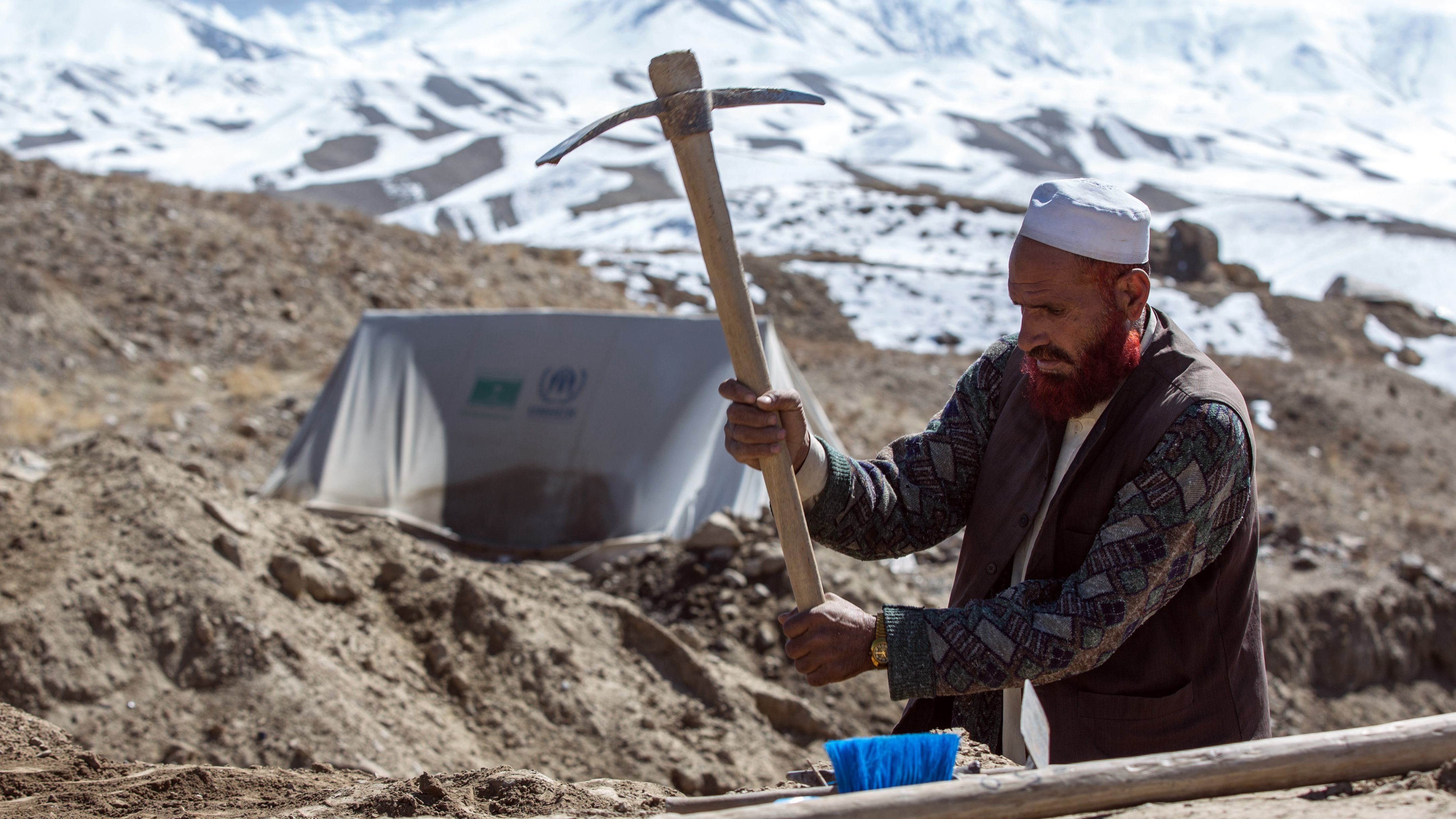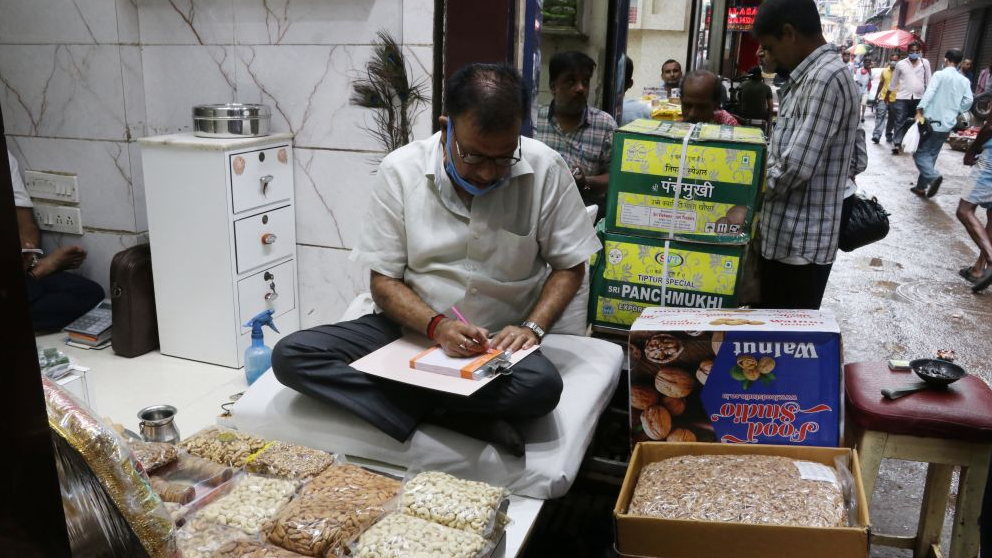
A local laborer excavate part of the mountaintop copper works above the ancient city at Mes Aynak in Afghanistan, which sits on the ancient Silk Road connecting China and India with the Mediterranean. /Getty
A local laborer excavate part of the mountaintop copper works above the ancient city at Mes Aynak in Afghanistan, which sits on the ancient Silk Road connecting China and India with the Mediterranean. /Getty
Editor's note: Djoomart Otorbaev is the former prime minister of the Kyrgyz Republic, a distinguished professor of the Belt and Road School of Beijing Normal University, and a member of Nizami Ganjavi International Center. This is the second piece of his series on the economy of Afghanistan. The article reflects the author's views and not necessarily those of CGTN.
Afghanistan's most significant economic challenge is finding a sustainable source of growth. The Taliban have already called on other countries to help Afghanistan "at a critical juncture in history" to create jobs and secure investment. Taliban spokesman Suhail Shaheen called on the international community to invest in Afghanistan's development, Ariana News reported on August 13. "We have just emerged from the stage of war and destruction and entered a new phase when the people of Afghanistan need help from other countries. They can come and develop our natural resources," he said, noting that the Taliban "appreciate the help of any state at such a critical moment in the history of Afghanistan."
Afghan subsoil is exceptionally rich in strategic resources indeed. For example, it has one of the world's largest unexploited reserves of copper, coal, iron, gas, cobalt, mercury, gold and thorium, valued at over $1 trillion. But one chemical element has especially unique potential for its development. It is lithium, a metal used in almost all batteries for mobile devices and electric vehicles. In 2010, a senior U.S. general told the New York Times that Afghanistan's mineral potential was "stunning." The paper also reported that an internal U.S. Department of Defence memo had said the country could become the "Saudi Arabia of lithium."
The potential to extract rare earth metals, such as praseodymium, cerium, lanthanum, neodymium and gadolinium, given the vast market demand and high prices, is exceptionally high. In 2014, based on the U.S. Geological Survey (USGS) research, the Afghan authorities announced that their value was approximately $3 trillion. The physical volume of lanthanides was at least 1.27 million tonnes.
However, against the background of the events in the country, it is not surprising that the international community has taken so far a wait-and-see attitude.
The leaders of the G7 countries met for a virtual meeting on August 24 to discuss the situation in Afghanistan. In the future, they would "judge the Afghan parties by their actions, not words." The announcement confirms their previous warnings to the Taliban to not return to the harsh Islamic form of government they followed in power from 1996 to 2001. "In particular, we reaffirm that the Taliban will be held accountable for their actions on preventing terrorism, on human rights, in particular, those of women, girls and minorities and on pursuing an inclusive political settlement in Afghanistan," the G7 leaders stated.

Prices of almonds, walnuts and apricots from Afghanistan have doubled and tripled over the past few days, said a trader at a wholesale market in Kolkata, India, August 21, 2021. /Getty
Prices of almonds, walnuts and apricots from Afghanistan have doubled and tripled over the past few days, said a trader at a wholesale market in Kolkata, India, August 21, 2021. /Getty
With better relations with the Taliban than the Western powers, Russia, China and Afghanistan's neighbors could benefit from investment in the country if the new government maintains control.
On August 19, Russian Foreign Ministry spokesperson Maria Zakharova noted that it was too early to comment on trade and economic relations between Moscow and Kabul. However, she added: "We have no reason to believe that they will not receive an impetus for further development after the establishment of the system of functioning of state structures and the restoration of tranquility in Afghan society."
On the Chinese part, Foreign Ministry spokesperson Hua Chunying announced that Beijing was ready for "friendly cooperation" with Afghanistan just a few hours after the Taliban seized Kabul. Many reports show that China is keen to stabilize the situation as soon as possible.
Two large infrastructure projects with Afghanistan's direct neighbors – Central Asian countries, India and Pakistan, could become especially important. Among them, the project for constructing the Kabul rail corridor from Termez in Uzbekistan to the Pakistani city of Peshawar through Mazar-i-Sharif and Kabul seems to be very relevant. The railway could carry up to 20 million tonnes of cargo per year. The section from Termez to Mazar-i-Sharif, built by Uzbekistan, has already been commissioned. The new government has yet to make the remaining 573-km section to Peshawar. The railway passage from Mazar-i-Sharif to Kabul, which, according to preliminary estimates, has a budget of $5 billion, is supposed to be built mainly with borrowed funds.
The other critical project would be the TAPI gas pipeline, named after the four countries it will pass – Turkmenistan, Afghanistan, Pakistan and India. The 1,814-km pipeline is to run from the Galkynysh Gas Field in Turkmenistan to the Indian city of Fazilka through Herat and Kandahar in Afghanistan and the Pakistani cities of Quetta and Multan. Its capacity would be 33 billion cubic meters of gas per year, and experts estimate its cost at $8 billion-$10 billion.
Even in the early stages of discussing these projects, senior Taliban representatives expressed direct support for those two initiatives in the form of security guarantees for their construction and further operation.
Regarding the development of the Afghan economy and infrastructure, it is pretty clear that any potential investor, regardless of its citizenship, would like to be confident in maintaining security in the country, observing civilized legislation and the rule of law.
A key question for any potential investor will be whether the Taliban can create the business environment and investment climate they need more effectively than the previous Afghan government. As in many other cases, the ball is now on the side of the Taliban.
(If you want to contribute and have specific expertise, please contact us at opinions@cgtn.com.)

